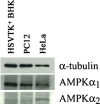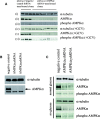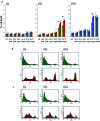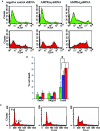5'AMP-activated protein kinase alpha deficiency enhances stress-induced apoptosis in BHK and PC12 cells
- PMID: 17488477
- PMCID: PMC3822827
- DOI: 10.1111/j.1582-4934.2007.00023.x
5'AMP-activated protein kinase alpha deficiency enhances stress-induced apoptosis in BHK and PC12 cells
Abstract
5'AMP-activated protein kinase (AMPK) activation occurs under a variety of stress conditions but the role of this enzyme in the promotion or inhibition of stress-induced cell death is unclear. To address this issue, we transformed two different cell lines with shRNA-expressing plasmids, targeting the alpha subunit of AMPK, and verified AMPKalpha downregulation. The cell lines were then stressed by exposure to medium without glucose (PC12 cells) or with the viral thymidine kinase-specific DNA replication inhibitors: acyclovir, penciclovir and ganciclovir (herpes simplex virus thymidine kinase-expressing Baby Hamster Kidney cells). In non-AMPK-downregulated cells, these stress treatments induced AMPK upregulation and phosphorylation, leaving open the question whether the association of AMPK activation with stress-induced cell death reflects a successful death-promoting or an ineffective death-inhibiting activity. In AMPKalpha-deficient cells (expressing AMPKalpha-specific shRNAs or treated with Compound C) exposure to low glucose medium or DNA replication inhibitors led to an enhancement of cell death, indicating that, under the conditions examined, the role of activated AMPK is not to promote, but to protect from or delay stress-induced cell death.
Figures








Similar articles
-
5'-AMP-activated protein kinase (AMPK) is induced by low-oxygen and glucose deprivation conditions found in solid-tumor microenvironments.Mol Cell Biol. 2006 Jul;26(14):5336-47. doi: 10.1128/MCB.00166-06. Mol Cell Biol. 2006. PMID: 16809770 Free PMC article.
-
Kinase-independent transcriptional co-activation of peroxisome proliferator-activated receptor alpha by AMP-activated protein kinase.Biochem J. 2004 Dec 1;384(Pt 2):295-305. doi: 10.1042/BJ20040955. Biochem J. 2004. PMID: 15312046 Free PMC article.
-
Identification of protein kinase D as a novel contraction-activated kinase linked to GLUT4-mediated glucose uptake, independent of AMPK.Cell Signal. 2008 Mar;20(3):543-56. doi: 10.1016/j.cellsig.2007.11.007. Epub 2007 Nov 26. Cell Signal. 2008. PMID: 18164589
-
Possible involvement of the alpha1 isoform of 5'AMP-activated protein kinase in oxidative stress-stimulated glucose transport in skeletal muscle.Am J Physiol Endocrinol Metab. 2004 Jul;287(1):E166-73. doi: 10.1152/ajpendo.00487.2003. Epub 2004 Mar 16. Am J Physiol Endocrinol Metab. 2004. PMID: 15026306
-
Model cell lines for the study of apoptosis in vitro.Methods Cell Biol. 2001;66:417-36. doi: 10.1016/s0091-679x(01)66019-9. Methods Cell Biol. 2001. PMID: 11396014 Review. No abstract available.
Cited by
-
Inhibition of AMP-activated protein kinase pathway sensitizes human leukemia K562 cells to nontoxic concentration of doxorubicin.Mol Cell Biochem. 2010 Jul;340(1-2):275-81. doi: 10.1007/s11010-010-0428-3. Epub 2010 Mar 26. Mol Cell Biochem. 2010. PMID: 20339906
-
AMPK Activation of PGC-1α/NRF-1-Dependent SELENOT Gene Transcription Promotes PACAP-Induced Neuroendocrine Cell Differentiation Through Tolerance to Oxidative Stress.Mol Neurobiol. 2019 Jun;56(6):4086-4101. doi: 10.1007/s12035-018-1352-x. Epub 2018 Sep 28. Mol Neurobiol. 2019. PMID: 30267375
-
AMPK inhibitor Compound C stimulates ceramide production and promotes Bax redistribution and apoptosis in MCF7 breast carcinoma cells.J Lipid Res. 2009 Dec;50(12):2389-97. doi: 10.1194/jlr.M900119-JLR200. Epub 2009 Jun 15. J Lipid Res. 2009. PMID: 19528633 Free PMC article.
-
AMPK Signaling Pathway as a Potential Therapeutic Target for Parkinson's Disease.Adv Pharm Bull. 2024 Mar;14(1):120-131. doi: 10.34172/apb.2024.013. Epub 2023 Oct 14. Adv Pharm Bull. 2024. PMID: 38585465 Free PMC article. Review.
-
Effect of metformin on the proliferation, migration, and MMP-2 and -9 expression of human umbilical vein endothelial cells.Mol Med Rep. 2012 Apr;5(4):1068-74. doi: 10.3892/mmr.2012.753. Epub 2012 Jan 12. Mol Med Rep. 2012. PMID: 22246099 Free PMC article.
References
-
- Culmsee C, Monnig J, Kemp BE, Mattson MP. AMP-activated protein kinase is highly expressed in neurons in the developing rat brain and promotes neuronal survival following glucose deprivation. J Mol Neurosci. 2001;17:45–58. - PubMed
-
- Stefanelli C, Stanic I, Bonavita F, Flamigni F, Pignatti C, Guarnieri C, Caldarera CM. Inhibition of glucocorticoid-induced apoptosis with 5-aminoimidazole- 4-carboxamide ribonucleoside, a cell-permeable activator of AMP-activated protein kinase. Biochem Biophys Res Commun. 1998;243:821–6. - PubMed
-
- Ido Y, Carling D, Ruderman N. Hyperglycemiainduced apoptosis in human umbilical vein endothelial cells: inhibition by the AMP-activated protein kinase activation. Diabetes. 2002;51:159–67. - PubMed
Publication types
MeSH terms
Substances
Grants and funding
LinkOut - more resources
Full Text Sources

